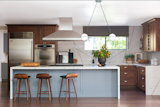This Multigenerational Bay Area Home Is Super Accessible With Style to Spare
For an experienced designer like Sherry Hope-Kennedy, principal of Studio SHK, improving a home for a family’s needs is quite standard. And at first impression, the list of improvements Alan and Joan provided as part of their renovation fit the mold. The two doctors with a pair of daughters had been living in their Bay Area home for some time, and they knew exactly what needed to be updated.
"The main floor, while it had square footage, was very cramped. A small, enclosed kitchen blocked flow and natural light, and the sunken living room felt disjointed," Hope-Kennedy says.
Alan and Joan hoped that their 3,500-square-foot property would soon be as picturesque as the oak trees in their neighborhood—they wanted to open their front door to a level floor plan filled with sunshine and storage. But more than anything, they saw this project as a way to make their two sets of parents feel comfortable during frequent extended visits—and their request for multigenerational accessibility distinguished them from other clients.
"The overall design intent was to establish a space that would accommodate the needs of the grandparents, whose mobility is limited, while still allowing Alan and Joan to live an active lifestyle with their kids," Hope-Kennedy adds.
In order to unify the ground level, Hope-Kennedy focused on raising the sunken living area to be the same height as the kitchen, while removing the wall that separated the two spaces. This eliminated the potential for trips or falls on stairs, and also allowed much more light to enter the home. Once a smooth, blank slate was in place, Hope-Kennedy turned her attention to the details that could accommodate various abilities with ease.
"A lot of the clutter was removed, which created accessible walkways and nooks, and recessed ceiling lighting makes the space easy to navigate at night," she says. "We also made the area more accessible with dual-purpose solutions. The bar seating extends into the adjacent dining room and can be used for large gatherings, and the ample space around the dining table makes it easy to walk around. And when it is not being used for dining, the table is a great work surface."
The color palette, on the other hand, only had to satisfy the requirements of two people: Alan and Joan. Hope-Kennedy wanted to achieve cohesion between midcentury modern and traditional tastes—a common his-and-hers compromise—while using some existing pieces like the magenta chairs they didn’t want to leave behind.
Shop the Look
"To make both of their styles work, we kept the walls and window treatments neutral, used richly colored wood tones for flooring and cabinetry, and added a pewter accent color in the kitchen to impart a feeling of sophistication," she says. "The colors work because there is a sense of balance. They feel warm and inviting, while at the same time being stylish and sophisticated."
Since the home was completed last year, everything on that initial list has been accomplished. Alan and Joan have a modern ground floor that their kids can enjoy, and it has more than enough storage to make the distinct areas feel as airy as they look. And whenever their parents shade their front door at the start of a long visit, they are welcomed into an accessible, thoughtful home.
Perhaps Alan and Joan’s needs are more of an anomaly now amongst clients, but that can change. If multigenerational design becomes more popular, Hope-Kennedy has this advice for other experienced designers to follow: "You can design for accessibility without sacrificing style, she says.
Related Reading:
This Home Proclaims Wheelchair Access Shouldn’t End Outdoors
How to Age Gracefully in Japan
Project Details:
Builder: Shaum Mehra, Oblique City
Structural Engineer: Ting Yuen, Larson Yuen Associates
Lighting and Interior Design: Sherry Hope-Kennedy, Studio SHK
Cabinetry Design: Scott Yates, Cabinets-Yates Woodworking
Published
Last Updated
Fill up on the Latest in Kitchen Design
Discover inspired kitchens and get design advice for the heart of your home.






